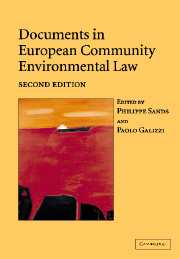Book contents
- Frontmatter
- Contents
- Preface
- PART I General principles of EC environmental law
- PART II European Community institutions and legislation
- PART III The relationship between environmental protection, financial assistance and free trade
- PART IV Procedural techniques of environmental protection
- 13 Council Directive 85/337/EEC of 27 June 1985 on the assessment of the effects of certain public and private projects on the environment (OJ L 175 05.07.1985 p. 40)
- 13A Directive 2001/42/EC of the European Parliament and of the Council of 27 June 2001 on the assessment of the effects of certain plans and programmes on the environment (OJ L 197 21.07.2001 p. 30)
- 14 Council Directive 96/61/EC of 24 September 1996 concerning integrated pollution prevention and control (OJ L 257 10.10.1996 p. 26)
- 15 Recommendation 2001/331/EC of the European Parliament and of the Council of 4 April 2001 providing for minimum criteria for environmental inspections in the Member States (OJ L 118 27.04.2001 p. 41)
- 16 Directive 2003/4/EC of the European Parliament and of the Council of 28 January 2003 on public access to environmental information and repealing Council Directive 90/313/EEC (OJ L 41 14.02.2003 p. 26)
- 17 Directive 2003/35/EC of the European Parliament and of the Council of 26 May 2003 providing for public participation in respect of the drawing up of certain plans and programmes relating to the environment and amending with regard to public participation and access to justice Council Directives 85/337/EEC and 96/61/EC (OJ L 156 25.06.2003 p. 17)
- 18 Directive 2004/35/EC of the European Parliament and of the Council of 21 April 2004 on environmental liability with regard to the prevention and remedying of environmental damage (OJ L 143 30.04.2004 p. 56)
- PART V Protection of air quality
- PART VI Biodiversity and nature conservation
- PART VII Waste
- PART VIII Dangerous substances
- PART IX Water quality
14 - Council Directive 96/61/EC of 24 September 1996 concerning integrated pollution prevention and control (OJ L 257 10.10.1996 p. 26)
from PART IV - Procedural techniques of environmental protection
Published online by Cambridge University Press: 06 January 2010
- Frontmatter
- Contents
- Preface
- PART I General principles of EC environmental law
- PART II European Community institutions and legislation
- PART III The relationship between environmental protection, financial assistance and free trade
- PART IV Procedural techniques of environmental protection
- 13 Council Directive 85/337/EEC of 27 June 1985 on the assessment of the effects of certain public and private projects on the environment (OJ L 175 05.07.1985 p. 40)
- 13A Directive 2001/42/EC of the European Parliament and of the Council of 27 June 2001 on the assessment of the effects of certain plans and programmes on the environment (OJ L 197 21.07.2001 p. 30)
- 14 Council Directive 96/61/EC of 24 September 1996 concerning integrated pollution prevention and control (OJ L 257 10.10.1996 p. 26)
- 15 Recommendation 2001/331/EC of the European Parliament and of the Council of 4 April 2001 providing for minimum criteria for environmental inspections in the Member States (OJ L 118 27.04.2001 p. 41)
- 16 Directive 2003/4/EC of the European Parliament and of the Council of 28 January 2003 on public access to environmental information and repealing Council Directive 90/313/EEC (OJ L 41 14.02.2003 p. 26)
- 17 Directive 2003/35/EC of the European Parliament and of the Council of 26 May 2003 providing for public participation in respect of the drawing up of certain plans and programmes relating to the environment and amending with regard to public participation and access to justice Council Directives 85/337/EEC and 96/61/EC (OJ L 156 25.06.2003 p. 17)
- 18 Directive 2004/35/EC of the European Parliament and of the Council of 21 April 2004 on environmental liability with regard to the prevention and remedying of environmental damage (OJ L 143 30.04.2004 p. 56)
- PART V Protection of air quality
- PART VI Biodiversity and nature conservation
- PART VII Waste
- PART VIII Dangerous substances
- PART IX Water quality
Summary
Editorial note
Council Directive 96/61 on integrated pollution prevention and control (IPPC) is designed to achieve integrated prevention and control of pollution arising from activities listed in Annex I to the Directive (energy industries, production and processing of metals, mineral industry, chemical industry, waste management, livestock farming, etc.). The Directive lays down measures designed to prevent or, where that is not practicable, to reduce emissions in the air, water and land from the above-mentioned activities, including measures concerning waste, in order to achieve a high level of protection of the environment taken as a whole (Article 1). The competent authorities of Member States are to ensure that installations subject to the Directive are operated in such a way that all the appropriate preventive measures are taken against pollution, in particular through application of the best available techniques; no significant pollution is caused; waste production is avoided or, where waste is produced, it is recovered or, where that is technically and economically impossible, it is disposed of while avoiding or reducing any impact on the environment; energy is used efficiently; the necessary measures are taken to prevent accidents and limit their consequences; and the necessary measures are taken upon definitive cessation of activities to avoid any pollution risk and return the site of operation to a satisfactory state (Article 3). New installations regulated by the Directive are to operate only with a permit issued in accordance with the Directive (Article 4). A transitional period (30 October 1999 to 30 October 2007) is laid down during which existing installations are to comply with the Directive.
- Type
- Chapter
- Information
- Documents in European Community Environmental Law , pp. 308 - 332Publisher: Cambridge University PressPrint publication year: 2006
- 3
- Cited by



